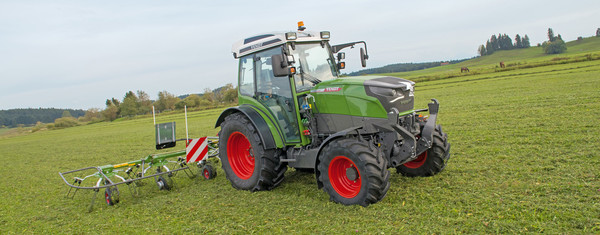
Electric traction in agriculture, a perspective issue
The agricultural mechanics industry is investing significant resources to develop electric motors able to replace, over time, those fueled with fossil fuels. The appropriate engine power and battery life are still a challenge from a technological point of view. On the other hand, for hybrid systems, effective solution in short times are possible
Most likely, thirty years ago few people imagined that today’s tractors would be able to operate in the field without the help of the driver (thanks to satellite guidance), and would be able to drive equipment capable of performing site-specific workings as well as automatically adjusting the feed rate in the field to reach the best work quality (with ISOBUS). And yet, all this is now a consolidated reality. Rather, we expected an evolution, perhaps even radical, of the types of energy sources to exploit, with the gradual decrease of fossil fuels, like what is happening in the automotive sector, where (albeit in small steps) the hybrid and integrally electric cars have begun to conquer perceptible market shares. Despite some hyper-experimental attempts, and at most some prototype models, up to now the road to develop a medium-high power tractor, which can work continuously for at least 10-12 hours thanks to the accumulated electrical energy alone on board (and at the same time allows to be reloaded in acceptable times), it still seems rather long.
John Deere’s SESAM
At the last SIMA in Paris, John Deere presented SESAM, a high power electric tractor, equipped with a lithium ion battery pack with a capacity of 150 kWh and driven by two 150 kW engines. It takes 3 hours to fully charge the batteries, while the complete discharge (with engines working 100%) takes 30 minutes. It is also true that the real working conditions sometimes deviate too much from this limit situation but, for example, plowing or ripping, on the other hand, are very close to it.
Fendt’s e100 Vario
More recently, Fendt presented to the press the e100 Vario, an all-electric compact tractor which was also awarded the Silver Medal at the Agritechnica 2017 Innovation Award. It is a prototype developed on the basis of the Fendt 200 Vario, where under the hood, instead of the traditional diesel engine, a 650 V battery with a capacity of about 100 kWh was installed, to power an electric motor capable of developing 50 kW.
With the engine at maximum, the autonomy reaches 2 hours, and in an operation such as plowing it probably gets to 2.5 hours. Owever, only for a very easy job (such as hay or hay turning) it is possible to ensure autonomy to complete a whole day’s work without supplies (top-ups). However, the adoption of batteries that accept high currents during charging allows the Fendt e100 Vario to bring back to 80% of its capacity in just 40 minutes.
The problem is energy density
Eventually, despite the significant technological progress achieved above all in the last 20 years, the technological limit for the development of all-electric tractors lies in the so-called “energy density”, ie in the amount of energy that can reasonably be stored on board. At the moment, no battery is able to approach the potential of fossil fuels. n terms of comparison, from 1 kg of diesel it is possible to obtain in ideal conditions about 45 MJ; taking into account the real efficiency of a modern Diesel engine (prudentially estimated at 33%), it means having 15MJ of mechanical energy per kg of diesel. On the contrary, 1 kg of the most modern lithium batteries (commercial type) can only offer 0.2 MJ. The most advanced prototypes (lithium sulfide) promise to reach almost 1.5 MJ/kg, while the lithium and thionyl chloride ones are 2.5 MJ/kg. Even if we hypothesize electric motors and highly efficient control units, which guarantee a conversion efficiency of 90% in mechanical energy, the enormous disparity still remains, that is to say, we face two orders of different sizes. Therefore, the road ahead to become really competitive with fossil fuels is very long.
The batteries’cost
Another knot to be solved is the rather high costs of current lithium batteries, despite the (easy) prediction of their drastic price reduction; within the next 10 years, a reduction from the current $ 600/kWh to $ 150/kW is expected. Anyway, considering the tax benefits for fuels for agricultural use, batteries in the agriculture field will become competitive much later than in the automotive sector. To date, commercially available solutions concerning all-electric vehicles in agriculture are limited to machinery that must work also for long periods, but with limited power absorptions, or conversely, vehicles which, although having the need to use rather large powers, need to work for rather short times. For example, the first category includes the fruit picking carts and the vineyard and orchard pruning carts, the ATV (All Terrain Vehicles also known as “Quad”) with reduced battery power, and some small self-propelled robots for mowing the grass, both in the maintenance of the green and in the rows of vineyards and orchards, in some cases even integrated with photovoltaic panels to increase the autonomy of the machine.
In the second category some telescopic handlers or the most common forklifts can be mentioned, but also the new and efficient Supertino’s self-propelled mulch wagon Electra 21, presented at the last edition of Agrilevante in Bari, where it has been very successful among the visitors. It is a machine with a 21 m3 container and with two vertical augers for cutting and mixing, which guarantees a couple of hours of operation and requires a charging time of about 3 hours. These “numbers” represent a more than adequate solution for medium-large stables, furthermore cheaper in management than a similar conventional model.
Outside these particular areas, considering the technological level currently available in terms of batteries, excessive euphoria for the electric solution is not currently justifiable.
Electric actuators
In any case, in a short time on tractors (and similar machines), there will probably be a gradual replacement of hydraulic actuators with electric ones, not only because of the best performance but above all because they ensure a more accurate control of the operations they oversee. At least for the next decade, the “full tank” on tractors will therefore still be done with diesel, because the diesel engine will remain the main solution, even if it will be flanked by methane-powered engines (increasingly of bio origin), or hydrogen will be exploited. Both these energy sources, however, highlight storage problems, and they also do not allow a long autonomy to the machines that exploit them.
The hybrid technology
A series of prototypes (more or less secrets ...) already exists on which the classic diesel engine is combined with an electric motor to provide a surplus of power when needed. On the contrary, when the resistive load is low, part of the power generated by the internal combustion engine is stored in the batteries on board. In these cases, as on common hybrid cars, when you need low power for short periods, the energy stored in the batteries is sufficient, without having to start the internal combustion engine. The advantages of the hybrids are many: first they consume less traditional fuel, since they exploit the internal combustion engine only in conditions of optimum efficiency (that is when it delivers the maximum of power), and then because they allow a reduction in the displacement, because any peaks in power demand for short periods can be satisfied by the electrical component. In this field, since the end of 2013, the Merlo Italian company proposes the TurboFarmer 40.7 Hydrid, a hybrid telescopic handler with a 56 kW diesel engine flanked by an electric motor powered by lithium batteries with a capacity of 30 kWh, which also allows the machine to work even in “full electric” mode.
The hybrid traction
Also, the traction which is ultimately the fundamental role of the agricultural tractor uses mixed diesel-electrical technical solutions to trigger the internal combustion engine to operate an electric generator, which supplies the various electric engines (often placed directly on the wheels and at the power take-off) with the power they need to operate them. In addition to having a fluidity of operation typical of the current CVT, it is also possible to obtain a performance comparable to that of the simpler mechanical transmissions. Further advantages could be found in the individual control of each wheel (with less localized slippage) with a consequent greater respect of the stand (especially during headland maneuvers), while the mechanical components would be somewhat simplified (eg differentials would no longer be necessary). An intermediate solution among those illustrated has been pursuing for years (more or less reservedly) a leading German manufacturer, which is experimenting with a continuously variable transmission where the hydraulic component is replaced with an electric one, to the benefit of a significant increase in efficiency of the transmission.
Still different is the Battery Boost recently developed by John Deere. Basically, a high capacity battery replaces the front ballast and is recharged by connecting to the mains.
In addition to the more accurate tractor’s balance, in this way it is possible to account for an extra power (which can be supplied for short periods) of 145 Hp (106 kW); it is a very convenient solution for carrying out heavy jobs that request power peaks, as typically the plowing and, more generally, when working deep in the ground.








